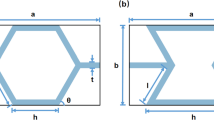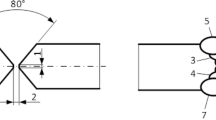Abstract
Using the unequal-thickness billet, a good cavity fill can be obtained in the local loading process of the large-scale complex component with high ribs and thin webs. However, the folding/lap defect is prone to occur in variable-thickness region of billet (VTRB) in the forming process. In this paper, the finite element method is adopted to study the deformation behavior of VTRB in local loading process. The evolution and reasons for the folding under the different transition patterns (stepping pattern, rounding pattern, beveling pattern, etc.) and the different located positions (die partitioning boundary, web region, rib cavity, etc.) of VTRB are analyzed systemically. The results of the present study may provide a basis for determination of the transition pattern and transition condition of VTRB for large-scale unequal-thickness billet.
Similar content being viewed by others
References
Shen G, Furrer D (2000) Manufacturing of aerospace forging. J Mater Process Technol 98(2):189–195
Welschof K, Kopp R (1987) Incremental forging—a flexible forming technology which improves energy and material efficiency. Aluminium 63(2):168–172 (in German)
Sarkisian JM, Palitsch JR, Zecco JJ (1999) Stepped, segmented, closed-die forging. United States Patent, Patent Number: 5950481
Shan DB, Xu WC, Si CH, Lu Y (2007) Research on local loading method for an aluminium-alloy hatch with ribs and thin webs. J Mater Process Technol 187–188:480–485
Yang H, Fan XG, Sun ZC, Guo LG, Zhan M (2011) Recent developments in plastic forming technology of titanium alloys. Sci China Technol Sci 54(2):490–501
Sun ZC, Yang H (2008) Mechanism of unequal deformation during large-scale complex integral component isothermal local loading forming. Steel Res Int 79(Special Edition 1):601–608
Altan T et al (1982) Modern forging: equipment, materials and process, Lu S, translated. Defence Industrial, Beijing (in Chinese)
Park JJ, Hwang HS (2007) Preform design for precision forging of an asymmetric rib-web type component. J Mater Process Technol 187–188:595–599
Kong TF, Chan LC, Lee TC (2008) Numerical and experiment investigation preform design in non-axisymmetric warm forming. Int J Adv Manuf Technol 37:908–919
Choi JC, Kim BM, Kim SW (1995) Computer-aided design of blockers for rib-web type forgings. J Mater Process Technol 54(1–4):314–321
Sun NG, Yang H, Sun ZC (2009) Optimization on the process of large titanium bulkhead isothermal closed-die forging. Rare Metal Mater Eng 38(7):1296–1300 (in Chinese)
Zhang DW, Yang H, Sun ZC (2010) Analysis of local loading forming for titanium-alloy T-shaped components using slab method. J Mater Process Technol 210(2):258–266
Zhang DW, Yang H, Sun ZC, Fan XG (2010) A new FE modeling method for isothermal local loading process of large-scale complex titanium alloy components based on DEFORM-3D. AIP Conference Proceedings 1252. American Institute of Physics, Melville, New York, USA, pp 439–446
Zhao G, Wright E, Grandhi RV (1995) Forging preform design with shape complexity control in simulating backward deformation. Int J Mach Tool Manuf 35(9):1225–1239
Hsing SH, Ho HL (2004) Investigation of the influence of various process parameters on the radial forging processes by the finite element method (FEM). Int J Adv Manuf Technol 23:627–635
Lee MC, Chung SH, Joun MS (2009) Automatic and precise simulation of multistage automatic cold-forging processes by combined analyses of two- and three-dimensional approaches. Int J Adv Manuf Technol 41:1–7
Sheu JJ, Yu CH (2009) Preform and forging process designs based on geometrical features using 2D and 3D FEM simulation. Int J Adv Manuf Technol 44:244–254
Altan T, Oh SI, Gegel HL (1983) Metal forming: fundamentals and application. American Society for Metals, Metal Park
Tang J, Oh SI, Altan T, Miller RA (1988) A knowledge based approach to automate forging design. J Mater Shap Technol 6(1):7–17
Dutta A, Rao AV (1997) Simulation of isothermal forging of compressor disc by combined numerical and physical modeling techniques. J Mater Process Technol 72(3):392–395
Li YY, Hu CR (2005) Experiment design and data processing. Chemical Industry Press, Beijing (in Chinese)
Taguchi G (1987) System of experiment design, Clausing D, translated. Kraus, New York
Author information
Authors and Affiliations
Corresponding author
Rights and permissions
About this article
Cite this article
Zhang, DW., Yang, H., Sun, ZC. et al. Deformation behavior of variable-thickness region of billet in rib-web component isothermal local loading process. Int J Adv Manuf Technol 63, 1–12 (2012). https://doi.org/10.1007/s00170-011-3855-8
Received:
Accepted:
Published:
Issue Date:
DOI: https://doi.org/10.1007/s00170-011-3855-8




